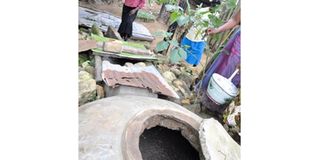Women group saves environment using biogas

Through the women’s group, several biogas digesters have been built. Photo by Edgar R. Batte
A group of women break into a rousing welcome song and dance as we get to Buwali village in Bududa district, an hour’s drive from Mbale town. They are members of Namasho Women Group, which is supported by UN Development Programme through the Uganda Ecosystem-based Adaptation (EBA) in Mountains Project.
The objective is to reduce vulnerability to climate change impacts in places like Bududa where these women live.
The group leader, Zippolah Wamoto, narrates that when they started out in 1990, they wanted to improve their lives through income-generating projects.
Assess impact
“We would buy and sell produce from farmers. From this, we made some profit and decided to buy land,” she recounts. After acquiring land, their next aspiration was to construct a building. In 2000, they began constructing it. In 2003, they held a fundraising drive that enabled them plaster the building.
The group that comprised nine, at formation in 1990, now has a membership of 45; most are residents of Buwali, Bumayoka and Bumasata parishes in Bududa.
It is at this building that they welcomed the UNDP staff, who are there to assess the impact and utilisation of a grant provided to the group through the World Wide Fund for Nature Uganda Country Office.
Address issues
The Shs750m grant was raised by UNDP from the Global Environment Facility (GEF) project to help the group strengthen climate change and early warning systems in the area.
GEF is a partnership of institutions, civil society organisations and private sector to address environment issues.
Wamoto explains that they have undertaken to construct biogas systems, which have provided energy for them and has enabled them save trees which they initially cut down for firewood.
Reduced fuel consumption
But Wamoto has a personal story to share about her change to biogas. Her daughter was raped by an unknown man as she went out to search for firewood in the tree.
She compares biogas to firewood, and explains that it is cleaner, easier and is faster when it comes to cooking. They use fuel-efficient stoves, which have reduced their expenditures by more than half.
Robert Wolibwa, chairperson of Nabuzo Environmental Conservation Group, says each household constructs a cook-stove in their kitchen, which has reduced fuel consumption by 60 per cent in this community. This way, forests are saved.
Less pressure on forests
The district leaders appreciate efforts to save the environment. Mbale’s deputy Resident District Commissioner, Pamela Wattis commended people in Mt Elgon area for reducing pressure on forest cover.
Explaining how biogas generates energy, Wamoto said fresh cow dung is run through a process that finally provides energy for cooking and lighting in her three-bedroom house.
She collects two basins of dung from her kraals, sorts out stone, grass and sticks from it before pouring into the mixing chambers.
Friendlier way to cook
“At the point of pouring it in the mixing chamber, it is semi-solid. It is released into the digester. In the digester, it is turned and produces a gas which comes up via a tube that delivers it to the entire house. After producing the gas, I use the dung in the garden as manure,” Wamoto explained.
She added that this has also provided a friendlier way to cook since she does not have to blow or inhale direct smoke as she used to do previously when she used firewood. With the gas, she has reduced the burden on her wallet. Her expenditure has reduced.
Investment and savings
“I used to buy paraffin every day at Shs5,000 for different lanterns because I have many rooms. Now, all I need is have enough dung to fire the biogas system for both lighting and cooking,” Wamoto noted.
The cow dung can generate three kilowatt hours of electricity. “I don’t cut trees as often as I used to. We use the slurry in our plantation as fertiliser. Money is used to do other things like pay school fees,” she added.
Wamoto spent Shs2.85m to construct the biogas system, Shs150, 000 on the casual labour, and the technical labour cost about Shs1m.
Wamoto also bought 18 bags of cement at Shs30,000 each, which came to Shs540,000 in addition to one trip of sand that cost Shs200,000 and one trip of aggregate at Shs250,000.
She needed to use lime and the builders required her to buy five bags. Each bag went for Shs25,000, which brought the total amount to Shs125,000. Waterproof cement was another requirement and each bag cost her Shs40,000.




